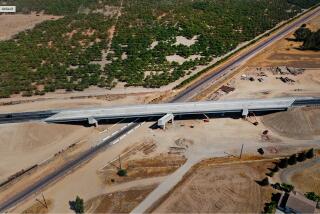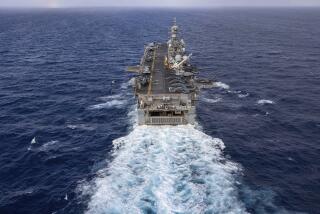Answering the Coast Guard’s SOS
- Share via
Tired of its image as a “second-class navy” outgunned by smugglers and stuck in the technological stone age, the Coast Guard hopes to spend more than $10 billion over the next 20 years to replace its fleet of aging ships, aircraft and communications systems.
The service wants to modernize a fleet whose fastest cutters strain to hit 33 mph, vainly trying to keep up with 70-mph drug boats zipping across the ocean. Its troops rely on eyesight to search for troubled vessels.
To upgrade its arsenal, the Coast Guard has been soliciting proposals from some of the nation’s largest defense contractors to overhaul the service with an integrated system of new ships, planes and satellite-based communications equipment. The program would replace the agency’s current fleet of 206 aircraft and 93 cutters that patrol the seas more than 50 miles offshore--hence its name, Operation Deepwater.
The project is part of a broader effort to fundamentally reshape the Coast Guard, which has been struggling to meet its multifaceted mission that includes stopping illegal fishing, nabbing smugglers and making rescues at sea.
It has had particular problems catching drug smugglers and illegal fishing operations that are using faster boats outfitted with cutting-edge sensors to evade detection.
The Coast Guard, which still operates cutters built during World War II, has ships and planes that are essentially “blind, deaf and dumb,” said Capt. Richard Kelly. Its ships have been in service an average of 29 years.
Three teams--led by Boeing Corp., Lockheed Martin Corp. and SAIC Corp.--are competing for the contract, which some analysts believe could grow to $20 billion over 40 years--making it one of the nation’s largest procurement programs. The Coast Guard is expected to award the initial five-year, $2.3-billion contract early next year.
“It’s the biggest thing that has ever happened to the Coast Guard,” said Loren Thompson, a defense analyst with the Lexington Institute, an Arlington, Va.-based conservative think thank. “It would recapitalize the entire service, not just ships and planes but communications systems.”
The price tag is high--$500 million a year. The Coast Guard’s current budget is $465 million for all procurement, everything from life vests to radar systems.
The General Accounting Office last month warned that Operation Deepwater could run into funding problems as Congress looks to cut spending as the softening U.S. economy hurts tax revenue. The agency also criticized the Coast Guard for underestimating the potential service life of its ships and aircraft, which the GAO said could be extended five years or more with maintenance and upgrades.
“The Deepwater acquisition strategy is unique and untried for a project of this magnitude, and it carries many risks which could potentially cause significant schedule delays and cost increases,” the GAO report said, adding it was concerned that costs could not be controlled under the planned contracting strategy.
The Bush administration recently forwarded the Coast Guard’s first-year development funding request of $338 million to Congress, which is expected to take up the issue this summer. The Coast Guard already has spent about $120 million to put together a preliminary plan.
The project “is enjoying fairly broad bipartisan support,” said Richard L. Aboulafia, director of aviation consulting for Fairfax, Va.-based Teal Group Corp. “Nuclear bombers are great targets to go after [for budget cuts], but Congress isn’t going to target money that is going to help stop drug smuggling and save people’s lives.”
The Coast Guard project would also provide a boost to the nation’s few remaining shipyards and aircraft makers, industries that have been languishing under tight defense budgets and increased competition from foreign companies. For even the largest shipyards such as Avondale in New Orleans, now a unit of Northrop Grumman Corp., and Bath Iron Works in Bath, Maine, the Coast Guard program would have a significant effect, executives of the companies said.
“It’s tremendous,” said Jay Dragone, Lockheed Martin’s director of Coast Guard programs. Lockheed, the nation’s largest defense contractor, has signed up Northrop’s Ingalls Shipbuilding in Pascagoula, Miss., in competing for the contract. “There really never has been a program of this size and scope. It’s got significant long-term implications for the winner.”
Although the Coast Guard’s motto is Semper Paratus, or Always Ready, analysts said the agency has had difficulty operating its aging fleet, which is based mostly on 1960s technology and hull design. Most of the ships were built between 1964 and 1972 and rely on outdated radar and communications systems. The Reliance-class cutters, for instance, use a type of diesel engine that is found on South African locomotives but nowhere else in the world, the Coast Guard says.
New sensors such as electro-optic and infrared equipment--standard on most military aircraft--virtually are nonexistent in the Coast Guard. Most illegal boats are spotted by human eyes--often from helicopters or airplanes, which then have to fly back to port to verbally relay the information, a Coast Guard official said. The instructions then are electronically transmitted over a secure line to a Coast Guard ship because the rudimentary air-to-surface radio communications can be easily intercepted.
Meanwhile, drug cartels have turned to so-called “go-fast” boats, sleek high-speed craft with up to four 250-horsepower engines and equipped with satellite equipment and night-vision goggles that can help them slip through anti-drug defense zones at 70 mph. The fastest ship in the Coast Guard’s fleet is the 110-foot patrol boat with a top speed of 33 mph.
The White House drug panel recently estimated that more than 400 missions are attempted each year by go-fast boats operating out of Latin American ports, but only about 15% of the boats are caught.
Search and rescue is another mission of the Coast Guard, which gets 70,000 distress calls and saves 3,600 lives each year. Many of the missions are conducted by a fleet that is among the oldest in the world. Among 39 world navies, the Coast Guard ranks 37th in the age of its cutters, just barely ahead of Mexico and the Philippines. (The U.S. Navy ranks No. 1 with the youngest fleet). The service life of most of the Coast Guard’s cutters will expire in the next decade.
In a recent search-and-rescue mission off Alaska, it took the Coast Guard 12 hours to find a distressed fishing boat because of severe weather conditions. The captain of the Coast Guard ship said a faster boat and better sensors on search planes could have located the boat sooner and perhaps saved the lives of 15 people who perished in the cold waters. A federal interagency task force concluded in a recent study that the Coast Guard was struggling to meet its mission because its “assets are old and technologically obsolete.” The panel said replacing the aging fleet should be a “national priority.”
“We’re spending more money and getting less operational time from that investment,” said Rear Adm. Patrick M. Stillman, executive officer for the Deepwater program. “At the same time, people are increasingly seeking in some shape or form to infringe on our sovereignty. The business is not waning in any respect.”
Moreover, ship captains say having an outdated, aging fleet is hurting recruitment as the Coast Guard competes with military services for a shrinking pool of young and technologically savvy enlistees.
“We need to be able to compete for people, and the young people these days are used to the technology and don’t want to be associated with an organization that doesn’t meet that need,” said Beverly Kelley, captain of the Coast Guard cutter Boutwell, based in the Bay Area. “We sometimes feel like a second-class Navy.”
Rather than replacing the cutters and aircraft one at a time, the Coast Guard is asking the potential contractor team to design an integrated system that would combine cutting-edge technology with new aircraft and ships.
The procurement process, which officials say would be the first of its kind in the federal government, essentially asks the prime contractor to do all the work, including designing, buying, determining how many and what kind of equipment would be needed by the Coast Guard as well as maintaining them. Under the agency’s plan, the contractor would be given a budget of about $500 million a year for the next 20 years.
“The Coast Guard is looking to the industry team, not just to come up with ship and aircraft design but to find a method of transforming its missions,” said Randy Belote, spokesman for Los Angeles-based Northrop, whose Avondale shipyard is teamed with Boeing’s Strategic Systems business based in Anaheim.
Although all three teams are keeping their proposals secret, the new Coast Guard may involve using unmanned aerial reconnaissance vehicles that can stay aloft for 30 hours or more and carry sophisticated sensors to spot smugglers or pinpoint troubled boats.
Satellite-based communications are likely to make up the backbone of the integrated system, which eventually may involve purchasing military-type aircraft such as the V-22 tilt-rotor, which can fly like a fixed-wing plane and hover like a helicopter.
To keep costs down, the Coast Guard said, it wants the teams to mostly consider off-the-shelf equipment and technology in designing the system rather than developing new ones.
“We won’t be inventing any new systems,” Stillman said. “We will only attempt to make improvements to make them fit our mission.”


